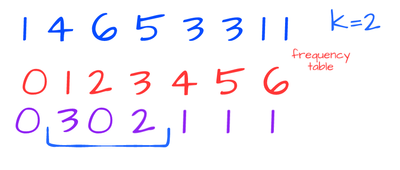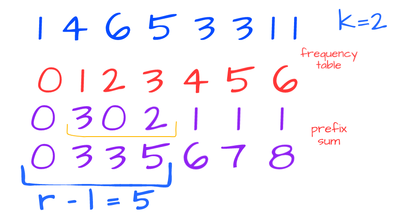See the original problem on HackerRank.
Solutions
Sorting
A C++ solution based on sorting and a sliding window made of two increasing
pointers:
1
2
3
4
5
6
7
8
9
10
11
12
13
14
15
16
17
18
19
20
21
22
23
24
25
26
27
28
29
30
31
32
33
34
35
36
|
#include <numeric>
#include <array>
#include <vector>
#include <iostream>
#include <algorithm>
#include <iterator>
using namespace std;
int main()
{
int n; cin >> n;
vector<int> v(n);
copy_n(istream_iterator<int>(cin), n, begin(v));
sort(begin(v), end(v));
auto selected = 0;
auto tail = begin(v);
auto head = next(tail);
while (head != end(v))
{
if (*head - *tail <= 1)
{
head++;
}
else
{
selected = max(selected, (int)distance(tail, head));
tail++;
}
}
selected = max(selected, (int)distance(tail, head));
cout << selected;
}
|
Basically, we stretch out the windows as far as the difference between the
endpoints is less than or equal to 1. When we find a greater difference, we
calculate the distance of the pointers (the length of the window) so far and we
increase the “tail” (the first endpoint). And so on.
We just need to take extra care of the possible case where all the elements are
equal. That’s handled on the line:
1
|
selected = max(selected, (int)distance(tail, head));
|
Frequency table
To avoid sorting and to maximize the performance when the size of the input
grows a lot, an alternative solution takes advantage of the domain: indeed,
adimissible numbers fall into the range \( [0-100] \) and then we can do a
statically sized array which stores all the occurrences. This is basically a way
to “compress” the duplicates into a single element.
From the problem, we know that only adjacent elements in the occurences array
(also known as frequency table) can be picked to maintain the constraint. So
it’s just the matter of calculating the maximum among all the adjacent pairs:
1
2
3
4
5
6
7
8
9
10
11
12
13
14
15
16
17
18
19
20
21
22
|
#include <array>
#include <numeric>
#include <vector>
#include <iostream>
#include <algorithm>
using namespace std;
int main()
{
int n; cin >> n;
array<int, 100> freq{};
while (cin >> n)
freq[n]++;
auto len = 0;
for (auto i=1; i<100; ++i)
{
len = max(len, freq[i]+freq[i-1]);
}
cout << len;
}
|
A pattern brings from the solution: we applied the zip | map | reduce
pipeline.
This pattern is easy to express in languages like Python:
1
2
3
4
5
6
7
8
9
10
11
12
13
|
def pickingNumbers(l):
freq=[0]*100
for i in l:
freq[i]+=1
zipped = zip(freq[1:], freq)
mapped = map(lambda p: p[1]+p[0], zipped)
return reduce(max, mapped)
if __name__ == "__main__":
n = int(raw_input().strip())
a = map(int, raw_input().strip().split(' '))
result = pickingNumbers(a)
print result
|
Just for completeness, in C++ we can rewrite the solution in terms of** inner_product**:
1
2
3
4
5
6
7
8
9
10
11
12
13
14
15
16
17
18
19
20
21
22
|
#include <numeric>
#include <array>
#include <vector>
#include <iostream>
#include <algorithm>
using namespace std;
int main()
{
int n, i; cin >> n;
array<int, 100> freq{};
while (cin >> i)
{
freq[i]++;
}
cout << inner_product(begin(freq), end(freq)-1,
next(begin(freq)), 0,
[](auto... args){
return max(args...);
},
plus<int>{});
}
|
Linq Solution by emanu_p81
1
2
3
4
5
6
7
8
9
10
11
|
static int pickingNumbers(int[] a) {
Dictionary<int, int> frequencies = Enumerable.Range(0, a.Max() + 2)
.ToDictionary(x => x, x => a.GroupBy(y => y)
.Where(c => c.Key == x)
.Select(f => f.Count())
.FirstOrDefault());
return frequencies
.Zip(frequencies.Skip(1), (x, y) => (x.Value + y.Value))
.Max();
}
|
Another solution by alepez
1
2
3
4
5
6
7
8
9
10
11
12
13
14
15
16
17
18
19
20
21
22
23
|
int pickingNumbers(vector<int> a) {
std::sort(begin(a), end(a));
auto l = begin(a);
auto r = next(l);
auto e = end(a);
int currSize = 1;
int maxSize = 1;
while (r < e) {
if (*r - *l <= 1) {
++currSize;
} else {
maxSize = max(currSize, maxSize);
l = r;
currSize = 1;
}
++r;
}
return maxSize;
}
|
C++ frequency table (alepez)
This is unreadable, but fits in 147 bytes of C++
1
2
3
|
#include <iostream>
int main(){int f[100]{};int n;while(std::cin>>n)++f[n];int m=0;
for(int i=1;i!=100;++i)m=std::max(m,f[i-1]+f[i]);std::cout<<m;}
|
ES6 frequency table + zip + reduce
1
2
3
4
5
6
7
8
9
|
const zip = (arr, ...arrs) => arr.map((val, i) => arrs.reduce((a, arr) => [...a, arr[i]], [val]));
const pickingNumbers = (a) => {
let freq = Array(100).fill(0);
a.forEach(n => ++freq[n]);
return zip(freq, freq.slice(1))
.slice(0, -1)
.reduce((max, p) => Math.max(max, p[0] + p[1]), 0);
}
|
Generalization
It’s possible to generalize this problem to any absolute difference, not just 1.
This change does not impact very much on the first solution because we just need
to change the condition of the if:
1
|
if (*head - *tail <= K)
|
On the other hand, generalizing the second solution is much more interesting.
When K=1 we have the original problem and we know that the solution is given by
calculating the max among all the adjacent pairs aggregations. If K increases,
then we still have to calculate the maximum of all the aggregations of adjacent
windows of size K+1 (with K=1, windows are just pairs):


We can do better. We can avoid aggregating numbers that we already aggregated in
a previous step. One simple way to implement this is by maintaining an
accumulator along the way and every time we move the window by one we subtract
the element “leaving the window” and, at the same time, we add the element
“entering the window”.
This is basically another pattern that we can implement in terms of the prefix
sum: every element of the prefix sum
in position \( i \) is the sum of all the elements from the beginning to \( i \).
Then we can manage a window of size K+2 and subtracing the two endpoints along the way:

The number of occurrences of the elements compressed in the frequency table will
be just the difference between the two endpoints. So we can still apply the
zip | map | reduce pattern just by changing the map:
1
2
3
4
5
6
7
8
9
10
11
12
13
14
15
16
17
18
19
20
21
22
23
|
#include <numeric>
#include <array>
#include <vector>
#include <iostream>
#include <algorithm>
using namespace std;
int main()
{
int n, i; cin >> n;
array<int, 100> freq{};
while (cin >> i)
{
freq[i]++;
}
int k=1;
partial_sum(begin(freq), end(freq), begin(freq));
cout << inner_product(next(begin(freq),k+1),
end(freq), begin(freq), 0,
[](auto...a){ return max(a...); },
minus<>{}
);
}
|


